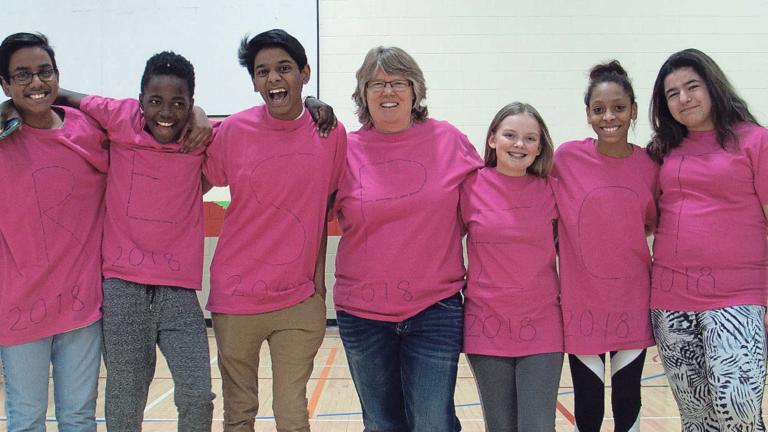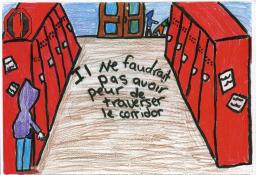Small acts can result in big change. Just ask Travis Price. In 2007, on his first day of Grade 12 at Central Kings Rural High School in Cambridge, Nova Scotia, he learned that a Grade 9 student had been bullied for wearing a pink shirt.
Travis Price’s act of kindness
The pink shirt idea that sparked an anti-bullying movement
By Julia Peristerakis
Published: February 22, 2019
Tags:

Photo: Canstar/The Herald, Sheldon Birnie
Story text
The bullies had harassed the younger student with homophobic insults and threatened to beat him up. As Price himself experienced bullying when he was younger, he felt motivated to make a difference for this student. To take a unified stand against bullying, he and his friend David Shepherd convinced hundreds of his fellow students to be “upstanders,” rather than bystanders, and wear pink clothes to school the next day. By turning an idea into action, Price and Shepherd started an annual campaign now known as Pink Shirt Day and sparked an international anti‐bullying movement.
Bullying is a form of ongoing targeted and intentional abuse by an individual or group. It can include name calling, taunting, threats, spreading rumours, intentionally leaving someone out, or physical violence like hitting, pushing or grabbing. Cyberbullying includes behaviours like sending hurtful content or demeaning others over text, email or social media.
The effects of bullying can have long‐lasting negative impacts on the targeted person’s mental and physical health. When young people experience bullying, it can lead to anxiety, depression, low self‐esteem and a higher risk of suicide. Bullying is very common – at least one in three adolescents in Canada have reported being subjected to bullying. Youth who identify as lesbian, gay, bisexual, transgender, two‐spirit or queer are much more likely to experience bullying in their lifetime.
Bullying can also violate a young person’s right to:
- be safe and free from violence and abuse,
- be protected from discrimination,
- receive an education, or
- develop to their fullest potential.
I want to be one of those people that continue to help people no matter the age, whatever the issue is, I just feel like I want to be able to help them.

An anti‐bullying illustration by Véronic LeBlanc of École Donat‐Robichaud in Cap‐Pelé, New Brunswick, carries the message: “You shouldn’t be afraid to walk down the hallway.”
Photo: École Donat-RobichaudTravis Price, co‐founder of Pink Shirt Day, knew first‐hand the effects of bullying, as he experienced bullying throughout elementary school. It started with other students calling him names and threatening him, and eventually progressed to physical violence. His parents became concerned as he withdrew from sports and seemed to be more and more unhappy. They spoke to school administrators who refused to step in, so his parents transferred him to a different school.
Our goal here is to make a day where kids can go to school and not be bullied.
A Day of Pink
Years later when Price started Grade 12 and heard about a younger student being bullied on the first day of school, he remembered how it felt to be on the receiving end of negative attention and how no one stood up for him when he needed it most. When the Grade 9 student was targeted and taunted by other students because he was wearing a pink polo shirt, Price and Shepherd saw injustice and decided to take action and make a difference for someone.
Video: Travis Price – Creating Pink Shirt Day
Price went out and bought 75 pink tank tops and accessories to hand out. Then, the two friends used social media to ask other students to wear pink the next day to support the young student and take a stand against bullying. It worked.
Hundreds of students showed up in rose‐coloured clothes, in what Price and Shepherd called a “sea of pink.” Price was especially moved to see the reaction of the young student when he walked through the doors to see so many students wearing pink. “You could see the weight that was lifted off his shoulders, to know that he wasn’t going to continue to be the bullied kid in school, that he was going to be just another kid in school, another student. He was going to be able to live his life,” said Price.

On Pink Shirt Day 2018, students from Maple Leaf School in Winnipeg hosted an anti‐bullying film festival which connected schools in communities across Manitoba and Nunavut.
Photo: Canstar/The Herald, Sheldon BirnieIt was just incredible to see how a group of students, a group of young people, could band together to support this student.
Pink Shirt Day is now celebrated every February across Canada to raise awareness about the negative impacts of bullying and to promote anti‐bullying initiatives in schools. Price continues to be an anti‐bullying advocate, going on school tours and sharing his story with students. There are now many other anti‐bullying campaigns, including Anti‐Bullying Day, International Stand Up to Bullying Day and Day of Pink. These events are held on various dates across Canada and internationally. Many pink‐themed events raise money for programs that combat bullying and promote acceptance of diversity.
Although the movement has continued to expand, Price feels that the end goal is to make every day a pink day. This means that students, and all of us really, should always reject bullying tactics and try to make a difference if we see someone being targeted. Instead of being bystanders, we should become upstanders. If comfortable, speak up in the moment and if not, tell a teacher and raise the issue with others who can take action. The story of Travis Price shows that one small act has the potential to inspire others to take action and stand up for inclusion.
For more information on bullying and bullying prevention, visit PREVNet.
If you are experiencing bullying and need help, call the Kids Help Phone: 1–800-668‑6868 or text CONNECT to 686868.
Ask yourself:
Have I unintentionally bullied someone in the past?
What steps can I take to prevent bullying?
What can I do if I see someone being bullied?
Suggested citation
Suggested citation : Julia Peristerakis. “Travis Price’s act of kindness.” Canadian Museum for Human Rights. Published February 22, 2019. https://humanrights.ca/story/travis-prices-act-kindness
